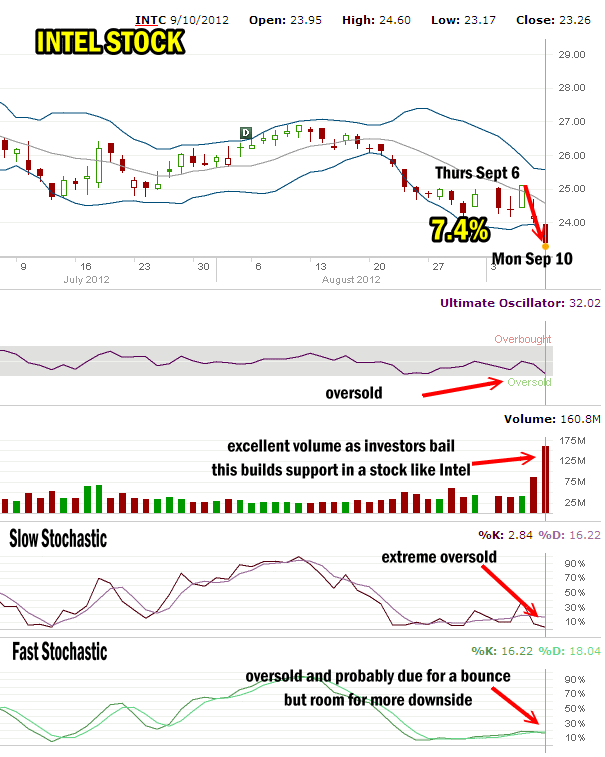Intel Stock is taking it on the chin by investors dumping shares on the earnings warning announcement. On Thursday last week Intel Stock closed at $25.10. Today (Monday Sept 10) Intel Stock closed at $23.26. This marks a loss of 7.4% in value or $1.84 in two days. Meanwhile though a lot of my naked puts are now in the money. I received lots of questions from investors wondering what is my plan. In my previous articles discussing my Intel Stock Put Selling trade I had outlined my plans of rolling any Intel Stock in the money puts until I was ready to accept shares of Intel Stock or the stock recovered and my naked puts ended up out of the money. In my Intel Stock article on August 24 I discussed rolling options strategy that could be used. I also indicated there was a very strong possibility that Intel Stock would fall below $25 and in my Intel Stock article on September 7 I indicated that $24 to $25 had limited support and that much stronger support would be found in $22 to $23. Today Intel Stock opened at $23.95 and fell to an intraday low of $23.17 on huge volume. The movement down in Intel Stock shows the value of knowing where support levels are. Once support broke at $24.00 there will be little support left until $23.00. As Intel Stock falls below $23.00 there will be more support. Today’s volume was exceptional and I would expect tomorrow to not be as high as today. Recalling past articles on support and resistance remember that every share sold was bought by another investor. This helps to build support as worried investors are replaced by those with different intentions.
Short-term Outlook For Intel Stock
The chart for Intel Stock shows the damage done. The stock set a new 52 week low on Monday Sept 10. The Ultimate Oscillator is now extremely oversold and if I add in the Slow and Fast Stochastic technical indicators I can see that Intel Stock should be due for a bounce. The Slow Stochastic is showing extremely oversold but while the fast stochastic is also very oversold, the fast stochastic is showing that there is still room for Intel Stock to fall further.
Intel Stock then could and should see a bounce. Following this though the stock may tread sideways and slowly grind lower as it falls into more solid support between $22 to $23 valuation levels.

The plunge in Intel Stock should result in a bounce but more downside may lie ahead.
Put Selling Intel Stock For Non-Stock Ownership
For investors not interested in owning shares of Intel Stock, Monday’s plunge was the first opportunity to earn decent premiums on Intel Stock at $22 and $21 put strikes. The Oct $22 Intel Stock puts could be sold on Monday for .33 cents. The Dec $21 at one point could have been sold for .55 cents. For investors who worry about stock ownership it is paramount to always be aware of support levels and sell puts below those support levels. Often that safety factor comes with poorer premiums.
I have great confidence in Intel Stock and have no problems selling at the money and as you can see from Monday’s action, holding in the money naked puts on Intel Stock. With its annual dividend of .90 cents yielding 3.87% on Monday’s close Intel Stock has a lot to offer investors. Intel Stock has a market cap of 116.4 billion, debt of just 12.84%. A payout ratio of just 34.1 times and profit margin of 22.73%. Price to cash flow of 6.1 times and book value of $9.18, this company is a monster in the semi-conductor industry. Intel chip sets are dominant.
Intel Stock In The Money Puts Strategies
So here are a few Put Selling strategies to consider when your Intel Stock puts up in, like most of mine, in the money. You can also see that I see no reason for concern with the pullback of Intel Stock. It has happened many times before and it will happen many times in the future I am sure.
Favorite Strategy: Rolling In The Money Naked Puts
For investors wondering what I would do, I plan to simply roll and reduce the number of put contracts making sure each roll ends with a credit. The capital I free up will be used to sell more Intel Stock naked puts as the stock falls lower. This is a simple strategy that I have used for years and it works very well. Not only do I continue to bring in income from my capital but I also reduce my overall cost basis in Intel Stock as I reduce the number of put contracts at higher strikes and sell more at lower strikes. This effectively also reduces the amount of capital in the entire trade which means I do not need to put more capital to work in Intel Stock naked puts as the reduction of put contracts at higher levels are replaced with put contracts at lower levels.
I always try to do the roll on the same day. Normally I use the Ultimate Oscillator which I set for 1 minute and wait for an overbought condition to buy back my in the money naked puts contracts and then wait for an oversold indication to roll and reduce the number of put contracts. If there is the chance to do a roll lower and reduce the put contracts as well as end up with a credit, all the better. Most times though it is a roll out to the same strike and reduce the number of put contracts.
Here’s a bit of an example. Presently these are the Intel Stock naked put positions I am holding:
5 Sept $26 naked puts for .48 cents
5 Sept $26 naked puts for .69 cents
10 Oct $25 naked puts for .50 cents
5 Oct $25 naked puts for .28 cents
10 Oct $24 naked puts for .35
5 Oct $24 naked puts for .52
10 October $23 naked puts for .38
Total Capital Committed = $123,500.00
All the above positions if they remain in the money will be bought back and rolled out further in time. The number of put contracts with each roll will be reduced and new Put Selling will occur in Intel Stock at lower strikes. I rarely roll until there is not much premium left in my sold naked puts.
Let’s take a quick look at a sample in the money put rolling options strategy.
Intel Stock Rolling Put Options
Intel Stock $26 Naked Puts
10 September $26 naked puts could be bought back today for $2.76. = Total cost to close = $2760.00
9 December $26 naked puts could be sold today for $3.15 = Total income earned = $2835.00
Total income earned = $75.00
I have freed up $2600 in capital which I can use for additional Put Selling.
Intel Stock $25 Naked Puts
15 Oct $25 naked puts could be bought back today for $1.93 = $2895.00
13 Dec $25 naked puts could be sold today for $2.36 = $3068.00
Total income earned = $173.00
I have freed up $5000 in capital which I can use for additional Put Selling.
Intel Stock $24 Naked Puts
15 Oct $24 naked puts could be bought back today for $1.19 = $1785.00
11 Jan $22.50 naked puts could be sold today for $1.87 = $2057.00
Total income earned = $272.00
I have freed up $9600 in capital which I can use for additional Put Selling.
Additional Intel Stock Put Selling
Meanwhile I am still holding 10 of the October $23 naked puts which I see no reason to cover yet.
Total freed up capital = $17200.00
I could consider Put Selling 800 Intel Stock shares of the Dec $21 naked puts for .47 cents. = $376.00
Total income earned =$2999.50
Original Amount Earned From Put Selling = $2103.50
Amount earned from rolling = $520.00
Amount earned from Put Selling December 21 = $376.00
Total Capital Now Committed = $122100.00
Total Number of Put Contracts sold = 51
Total Cost Basis should I be assigned on all shares = $23.94.
Each subsequent roll results in fewer naked put contracts at the higher strikes and more at lower strikes. The amount of capital in use can stay the same or for those less inclined to risk, they can pull out the capital that is freed up with subsequent rolls. This will however not result in the cost basis in the stock changing.
I prefer rolling in the money puts, reducing the number of put contracts with each roll and then using the freed up capital to sell more puts out of the money. By continuing to apply my capital out of the money I am lowering my cost basis in the stock. It also means that when if the time comes to accept shares, I may end up with a cost basis far below $23.00 which puts me back in the major support zone of $22 to $23. It also means that I may end up accepting fewer shares some time in the future rather than accepting all 5000 shares today. In other words, if Intel Stock falls to $21.00 in a couple of years time, I may end up with only 2000 shares with a cost basis of $22.50 and the balance of my capital still in use selling out of the money puts on Intel Stock.
My strategy for rolling in the money puts can only be done if an investor has confidence in the underlying stock. I have no problem with Intel Stock and can continue rolling strategies indefinitely. But it takes confidence in the underlying security. Without that confidence in a stock like Intel Stock, investors should re-evaluate their goal and objective.
It is very easy for an option seller to believe they are selling naked puts on stocks they would own, but when that stock pulls back dramatically as we have seen in Intel Stock, investors suddenly change their goal and decide they would rather not own shares in the underlying security that have sold puts against. This is the biggest detriment to growing capital. Continually taking losses, whether large or small, to get out of a naked put position destroys capital, increases anxiety and worry, and leaves a very bad experience which can take many investors months to overcome.
Instead by picking solid companies, taking small positions, setting up rolling strategies and waiting for put premiums to evaporate as the expiry month approaches, investors can continue to earn income, grow their capital and sleep well, knowing that their naked put positions, while deep in the money, are being well-managed by sound strategies that are growing their capital, lowering their cost basis and not requiring large infusions of additional capital. Intel Stock I believe meets this criteria which is why I started Put Selling at the September $26 strike.
There are many strategies for handling deep in the money naked puts. This is just one strategy I have used many times including on Intel Stock.
Internal Intel Stock Links
Review Intel Stock Trades For 2012
Review Intel Stock Trades For 2011
Review Intel Stock Trades For 2010
Intel Stock Trade Articles Index
External Intel Stock Links

